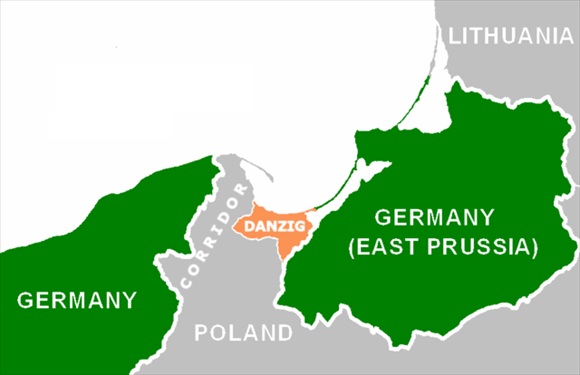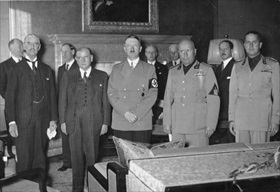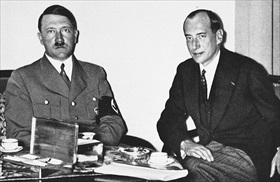HITLER PRESSES POLAND OVER DANZIG ENCLAVE
Berlin, Germany · January 5, 1939
On this date in 1939, eight months before the armed forces of Nazi Germany surged over Polish borders to launch World War II in Europe, German Chancellor Adolf Hitler told Poland’s visiting Foreign Minister Józef Beck that Germany would guarantee his country’s frontiers were a “final settlement” reached over the status of the League of Nations-protected port of Danzig (today’s Gdansk), Poland’s outlet on the Baltic Sea. Hitler reminded Beck, who was meeting the German head of state at his palatial Berghof retreat on the Obersalzberg in Bavaria, that Danzig had been a part of Prussia that had been lost in the victors’ peace following the First World War. Sooner or later, he said, Danzig—effectively a German-speaking outpost of the Third Reich surrounded by Poland—would again be part of Germany. Beck rejected demands for Danzig’s return, and did so again on March 26, 1939, after Hitler had gratuitously offered Slovakia to Poland in exchange for Danzig and German control of overland routes between the German heartland and East Prussia. (At Hitler’s urging Slovakia had declared its independence from the Czech-speaking western part of Czechoslovakia days earlier, on March 14.) Beck rejected Hitler’s offer even against the saber-rattling backdrop of Germany’s March 23 occupation of the former East Prussian “Memel Territory” (now Klaipėda Region), which had been handed to Lithuania, Poland’s neighbor to the northeast, following the Great War. Poland’s hubristic and obtuse leadership was unable to fully appreciate the flashpoint issues that consumed Hitler. So it was inevitable that Hitler should order concrete preparations for an assault on Poland, selecting September 1, 1939, as the start date. In the face of a worsening international situation during the spring and summer, German diplomatic feelers to Europe’s major capitals were a cover for plotting war, as Hitler remarked to his generals in May 1939. Danzig, he said, was not the real issue; it never was. The real issue “is an expansion of Lebensraum [living space] in the east,” meaning the Soviet Union. By solving “the Polish problem,” Hitler told his intimates, he would “create a foundation for the unavoidable fight with Russia.” Hitler’s problem-solving stratagem backfired horribly when the leaders of Britain and France fully comprehended the scale of Hitler’s continental ambitions, declaring war on the incorrigibly aggressive nation on September 3, 1939.
[amazon_carousel widget_type=”ASINList” width=”600″ height=”200″ title=”Recommended Reading” market_place=”US” shuffle_products=”False” show_border=”False” asin=”0781806739,0199676097,1841764086,0674284003,1849084793,0700613927,0465022057,1500890936,1906783845,0811707245″ /]
Stepping Stones to War, 1938–1939: Sudetenland, Memel, Danzig, and Polish Corridor
 |
Above: Interwar land corridor to the Baltic Sea and the semi-autonomous “Free City of Danzig,” 1920–1939. Both creations were carved from former German territory (West Prussia) so that newly independent Poland would not be dependent on German ports for its import/export trade. In May 1933 Hitler’s Nazi party gained control of the Danzig Senate. Like the ethnic Germans in Czechoslovakia’s Sudetenland in the mid-1930s, Danzig’s large ethnic German community strongly agitated to be incorporated into the Fatherland.
 |  |
Left: Posing stiffly for posterity from left to right: British Prime Minister Neville Chamberlain, French Prime Minister Édouard Daladier, German Chancellor Adolf Hitler, Italian Prime Minister Benito Mussolini, and Italian Foreign Minister Galeazzo Ciano. Leaders of the four European powers signed the Munich Agreement on September 30, 1938, which handed Czechoslovakia’s German-speaking Sudetenland to Germany. Chamberlain’s and Daladier’s misperception, miscomprehension, and misjudgment paved the way for Hitler’s repeated diplomatic successes in the late 1930s.
![]()
Right: Hitler and Polish Foreign Minister Józef Beck in 1937. Beck was the dominant figure in the Polish government and had been in the Polish Foreign Office since 1932. After Poland’s ambassador to Germany, Józef Lipski, had met with Hitler’s foreign minister, Joachim von Ribbentrop, on October 24, 1938, to hear the German suggestion that Danzig should be returned to Germany and a road-rail link be established across the Polish Corridor with extra-territorial rights for Germany over the route, Beck sensed that Hitler was set to embark on a “war of nerves” over Danzig. Exactly a month after that meeting, Hitler instructed the Wehrmacht to prepare a plan for seizing Danzig by force.
Silent German Propaganda Film “Liberation” of Danzig and Wehrmacht’s Assault on Poland, September 1939
![]()

 History buffs, there is good news! The Daily Chronicles of World War II is now available as an ebook for $4.99 on Amazon.com. Containing a year’s worth of dated entries from this website, the ebook brings the story of this tumultuous era to life in a compelling, authoritative, and succinct manner. Featuring inventive navigation aids, the ebook enables readers to instantly move forward or backward by month and date to different dated entries. Simple and elegant! Click
History buffs, there is good news! The Daily Chronicles of World War II is now available as an ebook for $4.99 on Amazon.com. Containing a year’s worth of dated entries from this website, the ebook brings the story of this tumultuous era to life in a compelling, authoritative, and succinct manner. Featuring inventive navigation aids, the ebook enables readers to instantly move forward or backward by month and date to different dated entries. Simple and elegant! Click 











